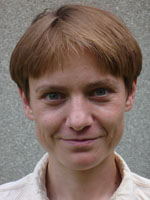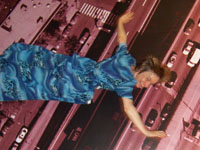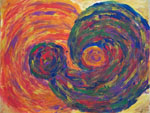 Which TDLC trainee recently won the prestigious 2009 Peter and Patricia Gruber International Research Award in Neuroscience, has a new lab at the Howard Hughes Medical Institute, completed a 100 mile run, and enjoys painting and writing poetry? This inspirational trainee is Dr. Eva Pastalkova.
Which TDLC trainee recently won the prestigious 2009 Peter and Patricia Gruber International Research Award in Neuroscience, has a new lab at the Howard Hughes Medical Institute, completed a 100 mile run, and enjoys painting and writing poetry? This inspirational trainee is Dr. Eva Pastalkova.
Dr. Pastalkova, a TDLC Interacting Memory Systems Network trainee in TDLC, recently completed her postdoctoral fellowship in the lab of Prof. György Buzsáki at Rutgers, the State Univ. of New Jersey. She is interested in the mechanisms that enable a brain to generate signals internally—signals that originate from inside of the brain and are not a result of environmental cues such as light, sound or touch.
Dr. Pastalkova, who received her PhD from Charles University in Prague, explains that a huge influence on her interest in neuroscience was the writing of Carl Jung. Jung wrote, “Man’s task is to become conscious of the contents that press upward from the unconscious.”
Dr. Pastalkova’s research is about studying just that – striving to become “conscious” of what happens in the “unconscious”. She and her advisor, Prof. Buzsáki, have designed an experiment where they can study the internally generated activity of a rat’s brain while the animal is performing a memory task. She investigates the activity of the hippocampus—the region of the brain responsible for spatial memory.
In the experiment, a rat has been trained to run through a corridor that is shaped like an infinity symbol. The animal is rewarded when it alternates between running through the left and right loops of the corridor. Between its runs through the maze, the rat must wait for 20 seconds while it runs on a wheel, located in the small holding area at the midpoint of the two loops. Dr. Pastalkova and her advisor, György Buzsáki, wondered what happens in the rat’s hippocampal neurons during this delay period – is the rat thinking about what its next choice should be?
They found that neurons fire in a similar pattern to that which appears when the rat is moving through the maze. Neurons light up sequentially, even without external cues in the environment that usually cause changes in brain activity. It is as if the rat is running through a corridor in its mind. “It seems like the animal is thinking of running a virtual trajectory … It’s kind of freaky, to peer into the mind of the rat,” Eva states.
The fact that activity can be generated solely by the brain itself fascinates Dr. Pastalkova. “How can it be that the brain is so creative? The human brain is a three-pound piece of tissue – a bunch of neurons. But it can produce thoughts, expressions, questions, and feelings. That a human brain made out of a group of cells can generate activity driven by inward thinking, not by perceptions and cues from the external world, is absolutely amazing.”
Her research raises numerous questions, as many cognitive abilities in people – such as emotional responses, decision making, and advance planning – may also be generated by internal brain functions. Dr. Pastalkova would next like to find out what other brain structures, in addition to the hippocampus, can produce internally generated activity, and in what other behavioral paradigms. And finally, how do neurons do this? “We can see that it happens,” she explains, “but we still do not know how the brain does it!”
Dr. Pastalkova has a chance to expand her research in her new lab at the Janelia Farm Research Center (a new center of the Howard Hughes Medical Institute for brain research) which she started in January 2010. There, she will explore the internally organized activity in the hippocampus, the entorhinal cortex, and the amygdala.
 She is especially excited to study emotions. She hopes to investigate whether she can define emotional states of animals based on internal cues – e.g. physiological measures such as breathing and heart rate, EKG, skin conductivity, and blood pressure. And if these functions describe the rats’ emotional states, can researchers study the brain activity that caused them? She is eager to find out.
She is especially excited to study emotions. She hopes to investigate whether she can define emotional states of animals based on internal cues – e.g. physiological measures such as breathing and heart rate, EKG, skin conductivity, and blood pressure. And if these functions describe the rats’ emotional states, can researchers study the brain activity that caused them? She is eager to find out.
Dr. Pastalkova’s dedication and talent have been recognized by The Society for Neuroscience (SfN), who awarded her The 2009 Peter and Patricia Gruber International Research Award in Neuroscience, an award that recognizes young scientists who have exhibited ongoing international collaboration based on outstanding science. In addition to her work on internally generated brain activity, Dr. Pastalkova was part of a team at SUNY Downstate Medical Center in Brooklyn that identified the molecule, PKMzeta. The molecule plays a central role in maintaining memories, and this research was recognized as a major advancement in the field of neuroscience. When the activity of the protein PKMzeta was blocked in the rat hippocampus, long-term memories were erased. This work also demonstrated that the mechanisms that maintain long-lasting connections between neurons are the same mechanisms that sustain spatial memory in rats. This finding was hailed by Science as one of 10 major breakthroughs in 2006.
Dr. Pastalkova’s fascination with the brain’s creativity resonates strongly in all aspects of her life. “This is a theme of my life. Everything that I do is to explore the capability of the brain to generate something.” She observes this process in the activities she loves: running, hiking, writing poems, and painting. “I love to translate my emotions into my paintings and poems,” she explains. “My brain tells my hands to move a certain way. The unconscious part of me makes the painting.” She continues, “My brain is processing so much more than I am conscious of, and in a meaningful way. That means to me that my brain understands my emotions and thoughts better than my conscious, and that I should let it tell me what is important to know consciously.” The same process occurs during her long runs: “When I need to understand something, especially related to emotions and relationships, I can introspect with greater ease and objectivity. Things start to make sense.”
Dr. Pastalkova is full of hope for the future. She believes that “The more we know about brain activity, the better we can help people” – for example, treat people with seizure, mood or psychiatric disorders. But she is realistic that it will be years before such research can be used in a clinical way. “We are all trying to be useful in the real world. We keep putting information about the brain together, little by little. That is how science works. These things will be used in the future … We are on the way there.”

![]()

![]()

Tempera painting and photographs by Eva Pastalkova
“That a human brain made out of a group of cells can generate activity driven by inward thinking ... is absolutely amazing”
![]() - Eva Pastalkova
- Eva Pastalkova